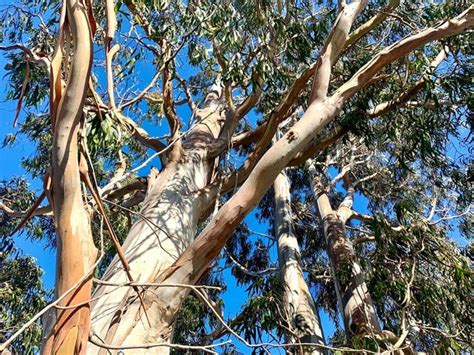The eucalyptus tree, an iconic fixture of the California landscape, has a rich and complex history that spans over a century. Native to Australia, these trees were first introduced to California in the mid-19th century, with the intention of providing a fast-growing source of timber and helping to prevent soil erosion. However, their impact on the environment and the local ecosystem has been far-reaching and multifaceted.
One of the primary reasons eucalyptus trees were introduced to California was to meet the demand for timber, which was escalating rapidly due to the Gold Rush and the subsequent population boom. The trees were seen as an ideal solution, as they grew quickly and could provide a reliable source of wood for construction and other purposes. However, it soon became apparent that eucalyptus trees were not well-suited for the California climate, and their introduction had a number of unintended consequences.
For example, eucalyptus trees are highly flammable, and their introduction to California has been linked to an increased risk of wildfires. The trees’ oily leaves and bark create a fire hazard, and their tall, slender trunks can act as a conduit for fire, allowing it to spread quickly from one tree to another. This has been a particular problem in areas where eucalyptus trees have been planted in large numbers, such as in the hills and mountains surrounding urban areas.
In addition to the fire risk, eucalyptus trees have also been linked to a number of other environmental problems. For example, they are highly competitive, and can outcompete native vegetation for water and nutrients. This can lead to a decline in biodiversity, as native plants and animals are pushed out by the invasive eucalyptus trees. Furthermore, the trees’ deep roots can also disrupt the local water cycle, reducing the amount of water available to other plants and animals.
Despite these problems, eucalyptus trees remain a common sight in California, and are often seen as a symbol of the state’s natural beauty. However, there is a growing recognition of the need to manage these trees in a more sustainable way, and to mitigate the negative impacts they can have on the environment. This can involve removing invasive eucalyptus trees, and replacing them with native vegetation. It can also involve implementing more sustainable forestry practices, such as selective logging and reforestation.
In terms of the benefits of eucalyptus trees, they do have a number of uses, including providing shade, improving air quality, and serving as a habitat for certain species of birds and insects. However, these benefits must be carefully weighed against the potential drawbacks, and efforts must be made to minimize the negative impacts of these trees on the environment.
In conclusion, the eucalyptus tree is a complex and multifaceted species that has had a profound impact on the California landscape. While they do have a number of benefits, their introduction has also had a number of unintended consequences, including an increased risk of wildfires and a decline in biodiversity. By adopting a more sustainable approach to land management, and working to mitigate the negative impacts of these trees, we can help to create a more balanced and thriving ecosystem.
Historical Context of Eucalyptus Trees in California

The introduction of eucalyptus trees to California dates back to the mid-19th century, when they were first brought to the state by Australian immigrants. The trees were seen as a promising solution to the state’s growing demand for timber, and were widely planted in the hills and mountains surrounding urban areas. However, it soon became apparent that eucalyptus trees were not well-suited for the California climate, and their introduction had a number of unintended consequences.
Over time, the popularity of eucalyptus trees as a timber crop has waxed and waned, with the trees experiencing a resurgence in popularity during the early 20th century. However, as concerns about the environmental impact of these trees have grown, so too has the recognition of the need to manage them in a more sustainable way.
| Year | |
|---|---|
| 1850s | Eucalyptus trees first introduced to California |
| 1900s | Eucalyptus trees experience a resurgence in popularity as a timber crop |
| 1950s | Concerns begin to grow about the environmental impact of eucalyptus trees |
| 2000s | Efforts begin to remove invasive eucalyptus trees and replace them with native vegetation |

- Assess the environmental impact of eucalyptus trees in your area
- Remove invasive eucalyptus trees and replace them with native vegetation
- Implement more sustainable forestry practices, such as selective logging and reforestation
- Monitor the ecosystem and make adjustments as needed
FAQs
What are the benefits of eucalyptus trees?
+Eucalyptus trees have a number of benefits, including providing shade, improving air quality, and serving as a habitat for certain species of birds and insects.
What are the drawbacks of eucalyptus trees?
+The drawbacks of eucalyptus trees include their high flammability, competitive nature, and ability to disrupt the local water cycle.
How can I manage eucalyptus trees in a more sustainable way?
+To manage eucalyptus trees in a more sustainable way, consider removing invasive trees, implementing more sustainable forestry practices, and monitoring the ecosystem to make adjustments as needed.
In terms of future trends, it is likely that the management of eucalyptus trees in California will continue to evolve, with a growing recognition of the need to balance the benefits of these trees with the potential drawbacks. By adopting a more sustainable approach to land management, and working to mitigate the negative impacts of these trees, we can help to create a more balanced and thriving ecosystem.


